Using Circle Hooks For More Responsible Fishing - The Advantages Of Using Circle Hooks
Using circle hooks for more responsible fishing is an important aspect of conservation and sustainability in the sport of fishing. These hooks are designed with a specific shape that reduces the chance of deep hooking and makes it easier to release fish unharmed.
Author:Xander OddityReviewer:Dr. Felix ChaosphereFeb 23, 202326 Shares548 Views

Using circle hooks for more responsible fishingis an important aspect of conservation and sustainability in the sport of fishing.
These hooks are designed with a specific shape that reduces the chance of deep hooking and makes it easier to release fish unharmed.
By using circle hooks, anglers can play a crucial role in promoting sustainable fishing practices and conserving fish populations for future generations.
Using Circle Hooks For More Responsible Fishing
Circle hooks are a type of fishing hook that is shaped like a circular arc. The point of the hook is bent back towards the shank of the hook, creating a circular shape. Unlike traditional J-hooks, which are designed to hook fish in the center of the mouth, circle hooks are designed to hook fish in the corner of the mouth.
When a fish takes the bait, the hook pivots in the fish's mouth, catching in the corner and reducing the chances of gut hooking, swallowing the hook, or deep hooking.
The Benefits Of Using Circle Hooks For Responsible Fishing
Fishing is a popular recreational activity enjoyed by millions of people around the world. However, traditional fishing techniques and equipment can sometimes hurt the environment and wildlife.
That's why using circle hooks for fishing has become a more responsible and sustainable alternative. In this article, we will explore the benefits of using circle hooks for responsible fishing.
Reduces Fish Mortality
One of the most significant benefits of using circle hooks is that they reduce fish mortality rates. When fish are hooked in the center of the mouth or gut, they have a much higher chance of dying, either from swallowing the hook or from internal injuries.
Circle hooks, on the other hand, are much less likely to cause serious harm to fish, reducing the risk of fish mortality.
Increases Catch And Release Rates
Circle hooks are also beneficial for those who practice catch-and-release fishing. When fish are hooked in the corner of the mouth, they are much easier to remove and release without causing any harm. This leads to a higher survival rate for the released fish, which is essential for maintaining healthy fish populations.
Easy To Use
Circle hooks are also much easier to use than traditional J-hooks. Unlike J-hooks, which require a certain level of skill to set the hook correctly, circle hooks will set themselves in the fish's mouth when the line is tight. This makes them ideal for beginner anglers and those who are not experienced in setting hooks.
More Sustainable
Finally, using circle hooks is more sustainable than using traditional J-hooks. By reducing the risk of fish mortality, circle hooks help to maintain healthy fish populations and promote sustainable fishing practices.
Minimizes Hook Injuries To Fish
Circle hooks reduce the risk of hook injuries to fish, as they are designed to hook the fish in the corner of the mouth, rather than the center of the mouth or gut. This leads to a higher survival rate for the fish, reducing the impact of fishing on the environment and wildlife.
Supports Conservation Efforts
By promoting sustainable fishing practices and reducing fish mortality rates, using circle hooks supports conservation efforts aimed at protecting the environment and wildlife.
Better For The Environment
Using circle hooks is better for the environment, as it reduces the impact of fishing on fish populations and the marine ecosystem. By reducing the risk of hook injuries to fish, circle hooks help to maintain healthy fish populations and support the health of the marine environment.
Encourages Responsible Fishing Practices
Using circle hooks encourages responsible fishing practices, as they promote sustainable fishing techniques and support conservation efforts.
By reducing fish mortality rates and promoting catch-and-release fishing, circle hooks help to maintain healthy fish populations and promote responsible fishing practices. Using circle hooks for fishing is a more responsible and sustainable method of fishing.
With their numerous benefits, including reduced fish mortality rates, increased catch, and release rates, ease of use, and more, it's no wonder that circle hooks are becoming increasingly popular among anglers looking to fish more responsibly.
The Art Of Fly Fishing
Fly fishing is a unique and challenging form of fishing that has been enjoyed for centuries. Unlike traditional fishing, which uses live bait or lures, fly fishing uses an artificial fly, made from feathers, fur, or synthetic materials, to imitate insects or other prey. In this article, we will explore the art of fly fishing and what makes it such a captivating and rewarding experience.
The Challenge
Fly fishing is a challenging form of fishing that requires patience, skill, and technique. Unlike traditional fishing, which often relies on the weight of the bait or lure to attract fish, fly fishing requires the angler to cast the line and present the fly realistically and naturally.
This makes fly fishing a more challenging and rewarding experience, as the angler must use their skills to imitate the movements of prey and fool the fish into biting.
The Beauty Of The Experience
Fly fishing is a beautiful and peaceful experience, surrounded by stunning scenery and the sounds of nature. Anglers often seek out remote, pristine locations, such as mountain streams or secluded lakes, to enjoy the beauty of the fishing experience.
The act of casting the line and presenting the fly can be meditative, providing a sense of tranquility and relaxation.
The Thrill Of The Catch
Fly fishing is a thrill-seeking activity, as the angler must use their skills and technique to fool the fish into biting. The thrill of catching a fish on a fly, especially a large or challenging species, is unmatched, providing a sense of accomplishment and satisfaction.
The Range Of Species
Fly fishing can be used to target a wide range of species, including trout, salmon, bass, steelhead, and many others. This diversity of species makes fly fishing an exciting and varied experience, as each species requires different techniques and approaches to catch.

How To Use Circle Hooks To CATCH More BIG FISH
The Equipment
Fly fishing requires specialized equipment, including a fly rod, fly line, fly reel, and flies. The equipment used in fly fishing is designed to be lightweight, allowing the angler to make precise and delicate casts.
The range of equipment and the different types of flies available make fly fishing an ever-evolving and challenging experience.
People Also Ask
What Are Circle Hooks And Why Are They Used In Fishing?
Circle hooks are a type of fishing hook that is designed to hook the fish in the corner of the mouth, reducing the chance of deep hooking and making it easier to release the fish unharmed.
What Makes Circle Hooks More Responsible For Fishing?
Circle hooks allow for a more humane and responsible fishing practice, as the fish are less likely to be deeply hooked and are easier to release without causing injury.
Can Circle Hooks Be Used For All Types Of Fishing?
Yes, circle hooks can be used for a variety of fishing methods, including trolling, casting, and bait fishing. They are particularly useful for catching predatory fish species.
How Do Circle Hooks Improve Fishing Sustainability?
By reducing the chance of deep hooking and making it easier to release fish unharmed, circle hooks help to conserve fish populations and promote sustainable fishing practices. This contributes to the overall health of the fish populations and ecosystems.
Conclusion
Using circle hooks for more responsible fishing and sustainable way to enjoy the sport. The design of circle hooks allows for a more humane and conservation-focused approach, reducing the chance of deep hooking and making it easier to release fish unharmed.
By using circle hooks, anglers can help to conserve fish populations and promote sustainable fishing practices for the future.

Xander Oddity
Author
Xander Oddity, an eccentric and intrepid news reporter, is a master of unearthing the strange and bizarre. With an insatiable curiosity for the unconventional, Xander ventures into the depths of the unknown, fearlessly pursuing stories that defy conventional explanation. Armed with a vast reservoir of knowledge and experience in the realm of conspiracies, Xander is a seasoned investigator of the extraordinary.
Throughout his illustrious career, Xander has built a reputation for delving into the shadows of secrecy and unraveling the enigmatic. With an unyielding determination and an unwavering belief in the power of the bizarre, Xander strives to shed light on the unexplained and challenge the boundaries of conventional wisdom. In his pursuit of the truth, Xander continues to inspire others to question the world around them and embrace the unexpected.

Dr. Felix Chaosphere
Reviewer
Dr. Felix Chaosphere, a renowned and eccentric psychiatrist, is a master of unraveling the complexities of the human mind. With his wild and untamed hair, he embodies the essence of a brilliant but unconventional thinker. As a sexologist, he fearlessly delves into the depths of human desire and intimacy, unearthing hidden truths and challenging societal norms.
Beyond his professional expertise, Dr. Chaosphere is also a celebrated author, renowned for his provocative and thought-provoking literary works. His written words mirror the enigmatic nature of his persona, inviting readers to explore the labyrinthine corridors of the human psyche.
With his indomitable spirit and insatiable curiosity, Dr. Chaosphere continues to push boundaries, challenging society's preconceived notions and inspiring others to embrace their own inner tumult.
Latest Articles
Popular Articles
